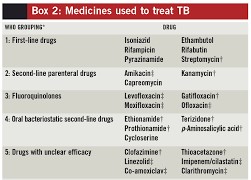Management and Treatment
- The management and treatment of TB aim to eradicate the infection, prevent transmission, and minimize complications.
- The mainstay of TB treatment is a combination of anti-TB drugs that are taken for at least six months. The most commonly used drugs are isoniazid, rifampin, ethambutol, and pyrazinamide.
- The choice and duration of drug therapy depend on factors such as the type and extent of TB, the drug susceptibility of the bacteria, the patient's adherence, and the presence of co-morbidities.
- Some patients may require longer or more intensive treatment, such as those with multidrug-resistant TB (MDR-TB) or extensively drug-resistant TB (XDR-TB), which are resistant to some or most of the first-line drugs. These patients may need second-line drugs, such as fluoroquinolones, injectable agents, and newer drugs like bedaquiline and delamanid. However, these drugs have more side effects and are less effective than the first-line drugs. Therefore, it is essential to ensure proper diagnosis, drug susceptibility testing, and monitoring of treatment response to optimize outcomes and prevent further resistance.
- The management of TB also involves supportive measures, such as:
- nutritional supplementation- Patients with TB should be advised to eat a balanced diet that provides adequate calories, protein, vitamins, and minerals to support healing and immune function. They should also drink plenty of fluids to prevent dehydration and help clear secretions.
- symptom relief- Patients may need analgesics, antipyretics, or anti-inflammatory drugs to relieve pain, fever, or inflammation caused by TB or its treatment.
- psychosocial support- Patients with TB may experience emotional distress, stigma, isolation, or depression due to their condition. They should be offered counseling, peer support, or referral to mental health services as needed.
- patient education- Patients should also be educated about the nature, transmission, prevention, and treatment of TB. They should be encouraged to adhere to their medication regimen, report any adverse effects or signs of treatment failure, and complete their course of therapy. They should also be taught how to prevent spreading the infection to others by covering their mouth and nose when coughing or sneezing, disposing of tissues properly, washing their hands frequently, and avoiding close contact with others until they are no longer infectious.

Nursing Test Bank
Naxlex Comprehensive Predictor Exams
Questions on Management and Treatment
Correct Answer is B
Explanation
Correct Answer is C
Explanation
Correct Answer is A
Explanation
Correct Answer is A
Explanation
Correct Answer is A
Explanation
Correct Answer is C
Explanation
Correct Answer is A
Explanation
Correct Answer is A
Explanation
Correct Answer is C
Explanation
Correct Answer is A
Explanation
Correct Answer is C
Explanation
Correct Answer is C
Explanation
Correct Answer is B
Explanation
Correct Answer is D
Explanation
Correct Answer is D
Explanation
Correct Answer is C
Explanation
Correct Answer is B
Explanation
Correct Answer is D
Explanation
Search Here
Related Topics
More on Nursing
- Pathophysiology of the Musculoskeletal System
- Pathophysiology of the Reproductive System
- Pathophysiology of the integumentary system
- Pathophysiology of the Hematologic System
- Pathophysiology of the renal system
- Pathophysiology of the Gastrointestinal System
- Pathophysiology of the Nervous System
- Basic Concepts of Pathophysiology
Free Nursing Study Materials
Access to all study guides and practice questions for nursing for free.
- Free Nursing Study Trials
- Free Nursing Video tutorials
- Free Nursing Practice Tests
- Free Exam and Study Modes
- Free Nursing Revision Quizlets
